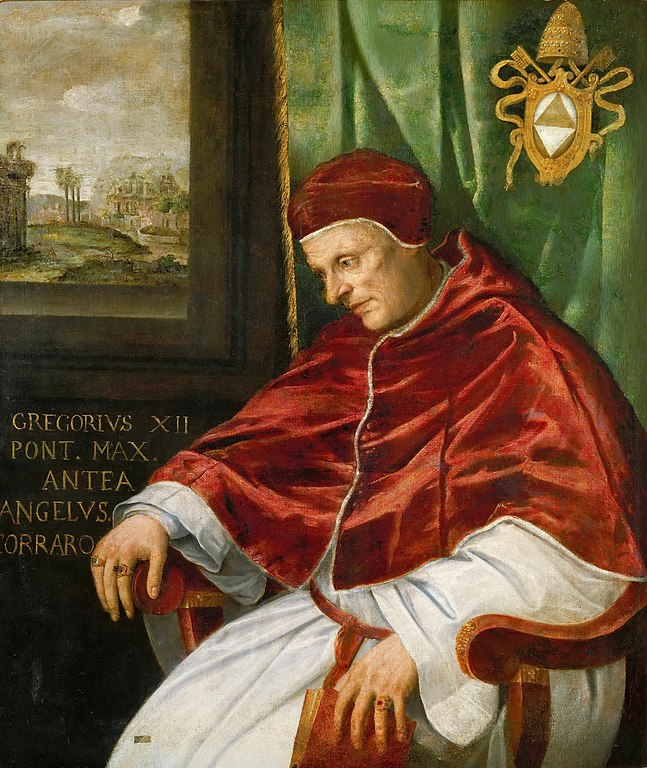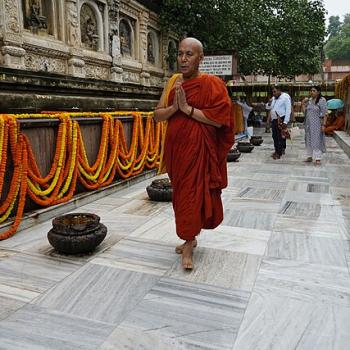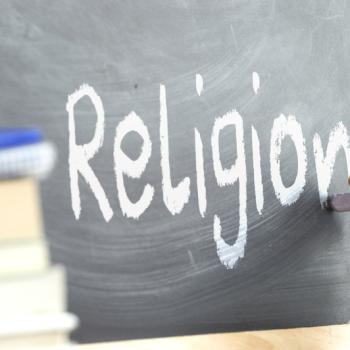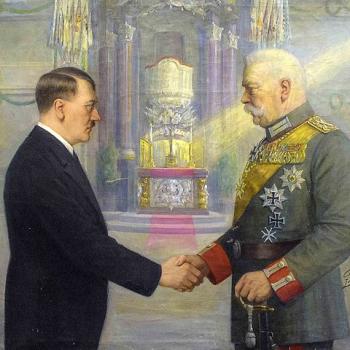Newspaper obituaries of the late Pope Emertus Benedict XVI (1927-2022) mention that he was the first pope in nearly 600 years to resign from the papacy. The last pope to resign was Pope Gregory XII, in 1415. And since papal resignations hardly ever happen, I wanted to know why Pope Gregory XII resigned. So I looked it up, and it’s a wild story.
I understand that when a pope voluntarily resigns from his office, the proper term for this act is renunciation, not resignation. So here is a brief history of papal renunciations.
The papacy is a nearly 2,000-year-old institution. One might think that meticulous records would have been kept all those years for such an important office, but no. There are some early popes who may have voluntarily resigned, or renounced, their office, but the records are not clear. These include St. Marcellinus, said to have been pope from 296 to 304, and John XVIII, in office 1004-1009. Plus there were a few other early popes who appear to have left office under less than voluntary circumstances. These were either forcibly deposed or bribed or otherwise given an offer they couldn’t refuse.
History counts just three popes who left the office voluntarily (and I’d argue that “voluntarily” barely applies to why Pope Gregory XII resigned). The first pope that we can say with some certainty resigned of his own free will was Celestine V, who was pope for only a few months in 1294. Celestine issued several edicts, one of which was that a pope had a right to resign. Then he resigned. He wanted to go back to the simple, secluded life he had enjoyed before he was elected pope. Unfortunately his successor, Boniface VIII, didn’t trust Celestine to not challenge his authority, and Boniface VIII kept the old hermit prisoner the rest of his life. Celestine V died in 1296 and was canonized in 1313 by Pope Clement V. He is now the patron saint of papal renunciations and bookbinders.
The Avignon Papacy
Gregory XII was pope from 1406 to 1415 and died in 1417. But to understand why Pope Gregory XII resigned, we have to skip back to an earlier episode of history called the Avignon Papacy. From 1309 to 1376 seven successive popes were headquartered at Avignon instead of Rome. Avignon is a lovely old city in the south of France, about 90 km or 60 miles northwest of Marseille. In the 14th century, strictly speaking, Avignon was not in France but in the Kingdom of Arles. But for the most part this was a meaningless distinction. Kings of France had enormous influence over what went on in the sumptuous Palais des Papes in Avignon.
The first pope to live in Avignon instead of Rome was the previously mentioned Clement V, who canonized Celestine V. Clement V had good reasons to stay out of Rome. In those days there was no independent Vatican City, and popes for a long time had been dragged into messy local city politics. And there was also a huge rift between the Church and France to deal with. King Phillippe IV of France and the previous Pope Boniface VIII — the pope who had imprisoned Celestine V — had literally been at war. Eventually a French army attacked the Pope’s palace outside Rome and held Boniface captive for three days. The Pope died of many injuries shortly after his release in 1303. Pope Boniface VIII was succeeded by Pope Benedict XI, who died the following year. The Conclave that elected the next pope was deadlocked for months, largely over the issue of what to do about France. Eventually the anti-France faction split, which enabled the election of the reasonably neutral Raymond Bertrand de Got, Archbishop of Bordeaux (at the time, part of England), who became Pope Clement V.
Clement V chose to move his papal seat to Avignon — again, near France but not part of France then — in part to mend relations between the Church and Phillippe IV, and also to try to keep peace between France and England. It was not intended to be a permanent move, but it nearly became one. The Church came to be dominated by France. The next six popes after Clement V were all French. Five of the popes who came after Clement V remained in Avignon. But the sixth, Gregory XI, chose to return the papacy to Rome in 1377.
The Papacy Splits in Two: The Great Schism
Gregory XI died in 1378, just a year after returning to Rome. When the Conclave met in Rome to choose a new pope, large crowds of Romans converged and called on the cardinals to choose a Roman Pope, not another French one. The cardinals chose Bartolomeo Prignano, Archbishop of Bari, who was Italian but not a Roman. The Archbishop became Pope Urban VI. Unfortunately Urban VI proved to be … difficult. According to some accounts, the cardinals regretted their choice after Urban VI told them to give up their ostentatious lifestyles and stop accepting money from monarchs and other laypeople. On the other hand, author Eamon Duffy (Saints and Sinners: A History of the Popes, Yale University Press, 2015) wrote that Urban VI “turned out to be violent, overbearing and probably clinically paranoid.” The cardinals couldn’t cope with him.
Six months after they had elected Urban VI the cardinals declared Urban VI’s election invalid — the mob of Romans had pressured them into it, they said — and chose instead the Cardinal Bishop of Geneva, who took the name Pope Clement VII. (Note that this Pope Clement VII is now recorded an “antipope,” and the “official” Clement VII was a different man who served as pope from 1523 to 1534.)
Now there were two popes. The 14th century Clement VII and the entire Curia — something like the papal administrative staff — returned to Avignon, while Urban VI appointed a new Curia for Rome. All of Catholicism was torn between the two popes. The two popes created rival colleges of cardinals and named different bishops and abbots to the same positions. This Great Schism didn’t end when Urban VI died in 1389, or when the antipope Clement VII died in 1394. Another pope was chosen in Rome; another pope was chosen in Avignon. In 1409 cardinals of both camps met to break the stalemate. Their solution was to depose both the Roman and Avignon popes and choose someone else, which they did. But then the Roman and Avignon popes refused to accept that they had been deposed, and so there were three popes.
Pope Gregory XII Resigned; the Great Schism Ended
The Great Schism was resolved by the Council of Constance, which met in Germany from 1414 to 1418 to address several issues. In regard to the Schism, the council voted to depose the Avignon pope and the “third” pope, but it allowed the Roman pope the grace of a dignified renunciation. And the Roman Pope was Gregory XII. He had been chosen in Rome in 1406 by small conclave of cardinals. The cardinals imposed a condition: If the Avignon pope were to renounce his claim to the papacy, the Roman pope would renounce his as well. When the Council of Constance dissolved other claims to the papacy, Gregory XII kept his part of the bargain and resigned, in 1415. He was succeeded by Pope Martin V.
The Avignon pope — now remembered as Antipope Benedict XIII — did not resign, but by then people were exhausted with the surplus of popes, so the Avignon pope had little support. When he died in 1423 a few cardinals chose a successor, but the successor reached an agreement with Rome to resign his claim to the papacy and recognize Pope Martin V as the one and true Pope. In return, the Avignon successor was appointed Bishop of Majorca.
The other extra pope, whom history calls Antipope John XXIII, appears to have more or less agreed to abide by the decision of the Council of Constance. Nevertheless he was imprisoned in Germany for some time and charged with various crimes. In 1418 he was ransomed by the Medici family. After that he went to Rome and submitted to the authority of Pope Martin V, who named him Cardinal Bishop of Frascati. And the Schism was over. The former Antipope John XXIII died a few months later, and the Medici family honored him with a gorgeous tomb.
The Resignation of Pope Benedict XVI
Nearly 600 years pass, and then Pope Benedict XVI resigned in 2013. He was 85 years old and felt too infirm to do the duties of his office. Historians someday may decide there were other reasons, but I’m not going to speculate about that.
One note — Pope Francis is expected to preside over the funeral of Benedict XVI, and some news stories have commented that it’s been a long time since one pope gave the funeral mass for a former pope. I’m wondering if it’s ever happened before. I doubt Boniface VIII bothered with a mass for poor Celestine V. It’s possible Martin V gave a mass for Gregory XII. But as these things are recorded, Martin V didn’t become pope officially until after Gregory XII had died. For two years there was no “official” pope, and Martin V may not have been made official at the time of Gregory XII’s funeral. But someone with better access to records than I have will have to look that one up.














